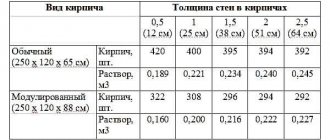The capacity of a bag for potatoes or other products, by a strange coincidence, in the vast majority of cases is not measured in liters, although this would be more logical for manufacturers. As usual, on sale you can find the volume of bags, which, for some reason, are expressed in kilograms. For example: 35 kg bags, 40 kg bags, 45 kg bags, 50 kg bags, 55 kg bags.
Method for calculating the number of liters of cement in bags
A value such as weight depends on the density of cement. Being a very loose substance, cement powder settles over time and becomes denser and stickier. During storage, particles of a substance become less light and there is less air between them. As you can see, the number of liters of cement in the same container can be different, therefore the density can be different.
It turns out that the density of cement, depending on its “youth” and storage conditions, can vary from 1100 kg/m3 to 1600 kg/m3. For calculations, we will take a conditional average density equal to 1300 kg per 1000 liters (one cubic meter).
We get the following calculations:
- 1300/1000 = 1.3 kg of cement powder contained in one liter.
A standard packaging bag contains 50 kg of cement, how many liters will be in one package? The question is simple: 50/1.3 = 38.46 liters of cement are contained in a standard 50-kilogram bag.
In a similar way, a calculation can be made to determine the amount of cement in a bag weighing 20, 25 and 40 kg.
How many buckets are in a bag?
How many standard 10 liter buckets can the bag hold? A very common belief is that a bag can fit 4 buckets of potatoes. Then the question arises: “How much does a bag of potatoes weigh 4 buckets?” But for some reason they forget that bags come in different sizes. Although in most cases this opinion is still true. It would be correct to first check the potato capacity of the specific bag that is available.
To make approximate calculations for measuring root vegetables in a bag without weighing and in the absence of scales, the volume of one bag is conventionally considered equal to 40 liters, but this is only conditionally, theoretically.
Mesh bags
Such bags usually hold 5 buckets of small potatoes; if the tubers are small, then a heap of them is possible. Although, of course, all bags are different and very different from each other in size and capacity. After all, their capacity, depending on the size and purpose, can range from 38 to 55 liters.
How much does a mesh bag of potatoes weigh? Mesh bags are available for sale, designed for five, ten, twenty, thirty kilograms.
Modern nylon bags for packing sugar and flour can hold about 50 kg of potatoes, this has been tested by experienced summer residents. The same can be said about the mesh bags in which onions or cabbage are usually packed. As for jute bags, up to 80 kg of tubers can easily fit into them. The inaccuracy in weight may be minus a couple of kilograms.
Bucket of potatoes
As mentioned above, when answering the question of how much a bag of potatoes weighs on average, it is advisable to first find out the weight of the tubers in the existing bucket, then measure the number of such buckets in the bag.
The mistake in calculating the weight of a bucket of potatoes is taking the true density of the potatoes as the starting point in the calculations. But this does not take into account its peculiar shape, which is inherent in tubers in nature. You should take into account the amount of air that necessarily enters the volume of the bucket with the root crops when filling it.
If you don’t go into details and long calculations, then the answer to the question, “How much does a bag of potatoes weigh?” is this: one standard 10-liter bucket holds from 6.5 to 7.5 kg of potatoes, and an average bag can be filled with 40 liters of tubers. Further calculations are not particularly difficult.
Calculation of the volume of a 50 kg bag of cement in liters and cubic meters
Cement mortar is used almost everywhere. Proper mixing depends on knowledge of physical characteristics, in particular volumetric weight. You can find various packaging on sale, but most often the weight of a bag of cement is 50 kg.
Factors that determine the amount of cement in a bag
Volumetric (specific) gravity depends on:
1. Density. When making a powder, each particle receives an electrical charge, which prevents it from “sticking” to others. But over time, this feature decreases, the density of cement increases, and therefore its volume decreases.
2. Production technologies. The fragmentation of the material is determined by the size of the cement grains themselves and the amount of air between them. The larger the particles, the lower the density, and, therefore, the greater the volume.
3. Vida. The density of cement depends on the composition. The main component is clinker, which is the result of the joint firing of limestone, clay and other minerals. The specific gravity of the granular mixture is 1000 – 1100 kg/m3, and that of the compacted mixture reaches 1700 kg/m3. The volume of Portland cement depends on the density of each component and their overall ratio.
4. Storage features. The volume of cement powder increases when stored in a humid environment.
5. Stamps. M500 cement has a higher specific density than M400, therefore, it occupies less volume.
Determination of packaging volume
Volume 50 kg cement
To answer the question: “How many cubic meters are in a bag of Portland cement?” you need to find out the number of kilograms in 1 m3. The density of the dry mixture can be different (900-2000 kg per 1 cubic meter). Its average value is 1300 kg per cubic meter. To calculate the volume of a bag weighing 50 kg, you need to divide its weight by the volumetric weight:
50: 1300 = 0.4 m3 or 40-42 l.
How many buckets are in a bag
In domestic construction, cement is often measured in buckets. In this regard, craftsmen must know exactly how many containers can be filled with cement from a bag weighing 50 kg. Knowing that a standard package contains 42 liters of Portland cement, let's calculate the number of buckets. For 50 kg of cement you will need buckets:
- 4.2 - 10-liter;
- 3.5 - 12-liter;
- 2.6 - 16-liter.
Cement in bags (different brands). Accurate determination of specific gravity
On average, the volume of 50 kg of cement is 0.038 cubic meters (38 liters). Weight of 1 cubic meter of mixture is 1300 kg. But this value may vary depending on the sample. For example, the difference in volume between the M400 and M500 brands will be 100 units. Concrete is stronger if, to calculate the amount of Portland cement, we take not the average value of the bulk density of cement, but its specific indicators:
| Brand | M100 | M200 | M300 | M400 | M500 |
| Volumetric weight (kg/m3) | 700 | 900 | 1100 | 1200 | 1300 |
Similar articles
- How many buckets are in a bag of cement if it is 20, 25, 50 kg?
The need to produce cement in bags is due to the rapid loss of quality upon contact with moisture and air, ease of transportation and storage... - Cement consumption per 1 cubic meter of concrete for foundations and walls, ratio of mortar components
Concrete is a building material consisting of gravel (crushed stone), cement-sand powder, water and special fillers. To make it... - How much cement is in 1 cube of concrete of different grades: table, composition, calculation of proportions
In civil and industrial construction, concrete still has no alternative. In a liquid state, it binds together the structural elements, after...
What is the difference between NC cement and Portland cement?
How much does a bucket of cement weigh - why do you need to know?
Calculation of the proportions of components for mixing concrete mortar is usually carried out in 12-liter buckets. And for sale, cement is packaged in packages weighing 50 kilograms (less commonly, a bag of cement weighs 20, 25 or 40 kg). If you decide to mix concrete yourself or prepare a solution for construction or finishing work, then to calculate the proportions ask yourself: how many buckets are in a 50 kg bag of cement and how many buckets of cement will you need at this stage of construction? Calculation technologies will make it possible to produce the required number of kilograms of cement mixture, so that it does not turn out to be less than necessary, and so that no excess is formed.
From theoretical scope to practical
The conclusion suggests itself that such a determination of the weight capacity of a bag is pointless to use to determine the weight of potato tubers in a mound. After all, the number of regulated kilograms in a bag has no connection with the weight of the root vegetables placed in it.
The bag is a universal container. You can pour completely different products, objects, fruits, vegetables and potato tubers into it. To more or less accurately measure weight and answer the question of how much a bag of potatoes weighs, you need to calculate its displacement.
How to find out how many liters are in an existing bag? For the greatest accuracy, an experimental method is suitable. To do this, you need to pour potatoes from buckets into it, because their capacity in liters is necessarily marked on the product itself (you should look at the bottom).











